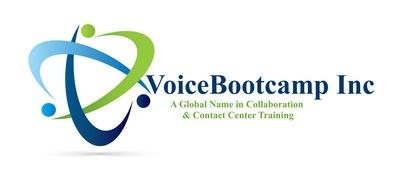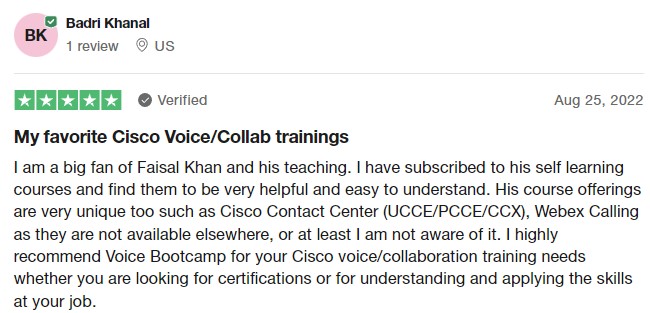Tel: 1-866-777-0060 | Request For Information
Cisco CCNP Collaboration 3.1 Video Training
Introducing the Cisco CCNP Collaboration Study Kit, your ultimate companion in mastering the intricacies of advanced collaboration technologies. This comprehensive study kit is carefully designed to help aspiring IT professionals and seasoned network engineers alike to enhance their skills and achieve the prestigious Cisco Certified Network Professional (CCNP) Collaboration certification.
Price $899 - Package Include:
- Implementing Cisco Collaboration Core Technologies - CLCOR 350-801
- Implementing Cisco Collaboration Applications (CLICA 300-810)
- Implementing Cisco Collaboration Conferencing (CLCNF)
- Cisco WebEx Calling Study Kits
- 40 Hours of Lab Access
Buy Platinum Package by April 30, 2024
& Get One of the Course For FREE
Cisco WebEx Calling Professional - 5 Days - $2,499 - FREE
Cisco WebEx Contact Center Expert - 5 Days - $2,499 - FREE
Genesys Cloud Contact Center - 5 Days - $2,499 - FREE
Amazon Connect Contact Center - 5 Days - $2,499 - FREE
Microsoft Team Voice - 5 Days - $2,499 - FREE
Content Outline
Implementing Cisco Collaboration Core Technologies - CLCOR 350-801
- Chapter 1.1 - Cisco Collaboration Solutions Architecture - Overview
- Chapter 1.2 - Cisco Collaboration Solutions Architecture - Deployment and Licenses
- Chapter 1.3 - Cisco Collaboration Solutions Architecture - High Availability and Redundancy
- Chapter 1.4 - Cisco Collaboration Solutions Architecture - Certificates
- Chapter 1.5 - Cisco Collaboration Solutions Architecture - Disaster Recovery and Backup
- Chapter 1.6 - Cisco Collaboration Solutions Architecture - IP Network Protocols
- Chapter 1.7 - Cisco Collaboration Solutions Architecture - Overview of Codecs
- Chapter 2.1 - Exploring Call Signaling over IP Network - Phone Bootup and On Cluster Call
- Chapter 2.2 - Exploring Call Signaling over IP Network - Phone Initialization and SIP Signals
- Chapter 3.1 - Integrating Cisco Unified Communications Manager LDAP - Overview
- Chapter 3.2 - Integrating Cisco Unified Communications Manager LDAP - Synchronization and Authentication
- Chapter 3.3 - Integrating Cisco Unified Communications Manager LDAP - Access Control Grup
- Chapter 3.4 - Integrating Cisco Unified Communications Manager LDAP - Feature Group Template
- Chapter 4.1 - Implementing Cisco Unified Communications Manager Provisioning Features - Manual and Auto Registration
- Chapter 4.2 - Implementing Cisco Unified Communications Manager Provisioning Features - Bulk Administration Tools
- Chapter 4.3 - Implementing Cisco Unified Communications Manager Provisioning Features - Self Provision Part 1
- Chapter 5.0 - Exploring Codecs
- Chapter 6.1 - Describing Dial Plans and Endpoint Addressing - Overview
- Chapter 6.2 - Describing Dial Plans and Endpoint Addressing - Endpoint Addressing
- Chapter 6.3 - Describing Dial Plans and Endpoint Addressing - Call Routing Process and Logic
- Chapter 6.4 - Describing Dial Plans and Endpoint Addressing - Addressing Method
- Chapter 6.5 - Describing Dial Plans and Endpoint Addressing - Variable Length Dialing and Urgent Priority
- Chapter 7.0 - Implementing MGCP Gateways
- Chapter 8.0 - Implementing Voice Gateways
- Chapter 9.0 - Configuring Calling Privileges in Cisco Unified Communications Manager
- Chapter 10 - Implementing Toll Fraud Prevention
- Chapter 11 - Implementing and Troubleshooting Media Resources in Cisco Unified Communications Manager Part 1
- Chapter 11 - Implementing and Troubleshooting Media Resources in Cisco Unified Communications Manager Part 2
- Chapter 11 - Implementing and Troubleshooting Media Resources in Cisco Unified Communications Manager Part 3
- Chapter 11 - Implementing and Troubleshooting Media Resources in Cisco Unified Communications Manager Part 4
- Chapter 12 - Describing Cisco Instant Messaging and Presence
- Chapter 13 - Enabling Cisco Jabber in Cisco Unified IM and Presence
- Chapter 14 - Configuring Cisco Unity Connection Integration
- Chapter 15 - Configuring Cisco Unity Connection Call Handlers
- Chapter 16 - Describing Collaboration Edge Architecture - Part 1 - Lab
- Chapter 16 - Describing Collaboration Edge Architecture - Part 1 - Lecture
- Chapter 17 - Analyzing Quality Issues in Converged Networks
- Chapter 18 - Defining QoS and QoS Models - Part 1
- Chapter 18 - Defining QoS and QoS Models - Part 2
Implementing Cisco Collaboration Applications (CLICA 300-810)
Implementing Cisco Collaboration Conferencing (CLCNF)
Cisco WebEx Calling Study Kits




